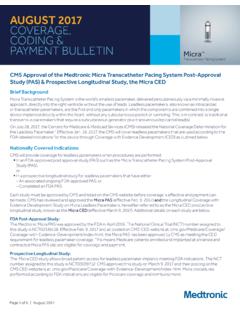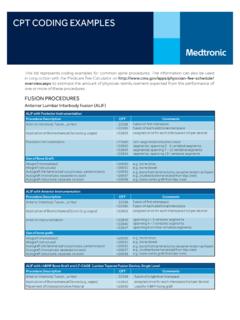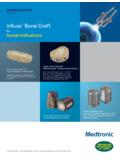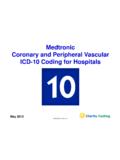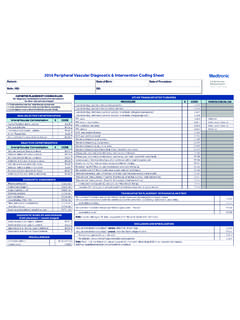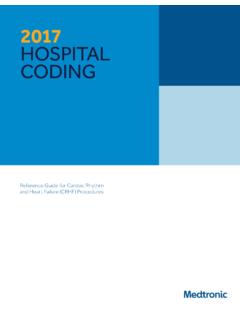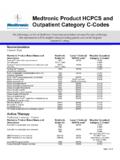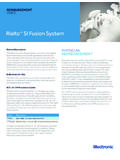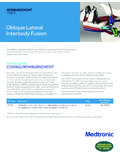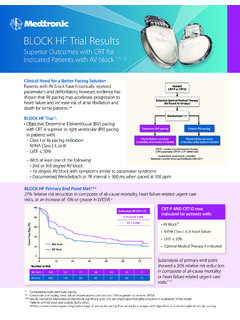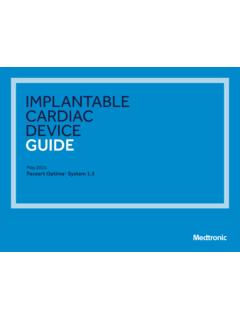Transcription of CLINIC CASE STUDY - Medtronic
1 CLINIC case STU DYCentraCare Heart & Vascular Center St. Cloud, MinnesotaThe Paceart optima System: A Central System for Improved Patient Care2 CLINIC case STUDY | CentraCare Heart & Vascular CenterOVERVIEWC entraCare Heart & Vascular Center at the St. Cloud Hospital in St. Cloud, Minnesota is a comprehensive heart center that performs follow-up appointments for approximately 90-120 patients a recently upgraded from the Medtronic Paceart Get Connected 3 System to the Paceart optima System, which they use as a centerpiece for their follow-up practice. The CentraCare team partnered closely with Medtronic to thoroughly understand the capabilities offered by the Paceart optima System, and to effectively implement the system in their workflow. In the 3 months since the upgraded system has been in place, the team of follow-up RNs has realized significant efficiencies due to the use of electronic in- CLINIC and remote patient management.
2 Given the simplicity of the solution, CentraCare went from 35 remote patients/day to 45-50 remote patients/day. More importantly, staff morale has reportedly climbed because of workflow efficiencies like reduced need for printing documents, seamless integration with electronic medical records and a reliable flow of information from their network of outreach centers. In addition, the department has grown in credibility with a superior follow-up record. Hospital staff increasingly see the Heart & Vascular Center as a destination department with a waiting list of nurses interested in working there. Best of all, patients receive consistent, high levels of HIGHLIGHTSE lectrophysiology Staff Six nurses (roughly 700 patients per nurse) Four full-time technicians/schedulersPatients Currently Monitored4,300 patientsSatellite Locations14 outreach clinics located in rural hospitals, visited monthly by nursing staffUse of Remote MonitoringRoughly 90% of patients monitored remotelyResources Seven CLINIC rooms set up for in-person visits Two rooms for telephone checks Single large workroom for schedulingClinic FocusMonitor Pacemakers, ICDs, CRT Devices, and Insertable Cardiac MonitorsKey Benefits Nurses can read more remotes due to efficiencies inherent in electronic follow-up versus printing, handling, carrying and delivering printed reports for scanning Ongoing savings because of move to paperless.
3 62% savings in paper purchasing 75% savings in ink purchasingClinic case STUDY | CentraCare Heart & Vascular Center3 TEAM TRANSITION TO SIMPLIFIED CONNECTIVITYL aura Van Heel is a first-hand witness to the evolution of pacing and defibrillation. She has been working with pacemaker patients for over 30 years and has seen the treatment capacity and complexity of implantable devices grow over the years. Today s patients arrive at the CLINIC with a mix of implantable devices that includes pacemakers, defibrillators, and cardiac resynchronization devices, along with implantable loop recorders. Van Heel s team had used an earlier version of the Paceart System, Paceart Get Connected 3 System software, before engaging with Medtronic to help plan and implement the new Paceart optima System software. The team loved the earlier version but soon began to appreciate the efficiencies of the new system, like easily pulling in patient data, connectivity to a variety of programmers, and the ability to attach documentation to a patient s electronic record.
4 The team approach to learning the new system helped the entire team use the system more fully. Nursing staff, schedulers, and the IT staff were trained in the technology so each interaction would align with the larger department and hospital goals. Van Heel even requires schedulers to understand the Paceart optima System. The result of staff training with Medtronic on the new Paceart optima System is that CentraCare is now a virtually paperless office, going from 30 reams of printer paper ($ ) used per week to less than 5 reams per week ($ ).RIGOROUS EFFICIENCY FOR A BUSY CLINICA round 100 follow-ups are performed each day among six nurses and seven CLINIC rooms. In the older, pre-Paceart optima System, paper-and-ink days, remote monitoring and then processing data for 35 records a day was the limit of what was possible for the staff especially given the thick sheaf of papers to sort and enter by hand, which must then be physically delivered to Medical Integrity and ConnectivityThe connectivity offered by the Paceart optima System is one key reason for increased department efficiency: With Paceart optima , all the patient data is pulled in right away, said Van Heel.
5 There is no reason for nurses to be data entry people. In fact, nurses work best when focused on patient care and management, and so that s what we always try to do: help people do what they are best at. The fact that the Paceart optima System allows attachments is a big reason why it is so helpful, according to Van Heel. And the CentraCare team takes full advantage of that ability, liberally attaching notes and documentation to create a full picture for each patient. The CareLink Network, of course, comes right over into the Paceart optima System, even with attachments. With other manufacturers, the team can go to their websites (for instance, and LATITUDE ) and pull in the interrogation data. Other manufacturers may require different methods for transferring data (for instance, the BIOTRONIK Home Monitoring System requires import by USB.)
6 And even though that is a little more work, it s worth the effort to get the information in our system and attached to Paceart optima , said Van Heel. I continue to watch the industry change and grow, said Van Heel (above), and tools such as Paceart optima are going to be the things that save us from having chaos. It [the whole team approach] is a bit unusual for some clinics, said Van Heel. Many clinics use general scheduling people. But here we think it is valuable for schedulers to understand how Paceart optima works, how to use the software for missed patients, to document telephone conversations and for follow-up care. CLINIC case STUDY | CentraCare Heart & Vascular Center4 Assigning tasks is another welcome improvement in the Paceart optima System. Even though Van Heel s staff has turned the patient over to another department, they can assign a task as a reminder to keep current on this particular patient and not lose track of them.
7 This is a plus for tracking patient safety-related issues as well as helping the team keep their promises about patient System for CLINIC EfficiencyThe volume of data amassed when following 4,300 patients annually is overwhelming amounting to approximately 15,000 encounters per year. That the Paceart optima System functions as a single data management system for most data needs is a huge plus for efficiency, according to Van Heel. Every bit of data goes into the WORKFLOW FOR IMPROVED PATIENT MANAGEMENT Editable Encounters for Efficient CollaborationEditable encounters highlight how the system was made for a team. In addition to easing work together, the single data management system has translated directly into a reduction of overtime, and more importantly, an increase in satisfaction, according to Van Heel. Prior to the Paceart optima System, the team required one to two hours of daily overtime to enter the bolus of data from paper records.
8 Habitual overtime became significant budget overruns. But because of resource management through the Paceart optima System, nurses actually get more done, processing 10-15 more remote follow-ups a day without adding to Paceart optima System as the single system for the CLINIC provides the opportunity for a seamless flow of data for most cardiac device patients and for all physicians. Not only has the system reduced six steps into one according to Van Heel, but the movement of data electronically is as convenient as it is efficient. Prior to using the Paceart optima System, nurses working from home carried stacks of paper plus a printer and a ream of paper to print reports (Figure 1). Moving stacks of paper was both physically exhausting and a motivational single electronic data management system did away with piles of paper to carry, especially since Van Heel s staff makes use of electronic signatures from clinicians.
9 Each day s data entry task became much more manageable (Figure 2). We suggested the staff do 40 follow-up records a day each, said Van Heel. They said No way. Thirty-five is all we can do. But with Paceart optima we can do 45 or 50 records, said Van Heel, and those 45 or 50 are completed with a lot less stress. Say one of our nurses comes in [to our workroom] to enter records, said Van Heel. With Paceart optima we immediately see which record she needs to address and which record the other person is working on. This allows for efficient sharing of the workload and improves team d y n a m i c s . We actually save one to two hours per day. Even though follow-ups continue to increase, our costs have not. But what s more important for me is that we have more satisfied nurses, said Van 1: Stacks of paper data entry followed by reams of printing before the Paceart optima 2: Electronic records made each day s follow-ups much more case STUDY | CentraCare Heart & Vascular Center5 Positive Finish with Each RecordFrom a workflow perspective, there is something satisfying about finishing a record.
10 In the previous system, there was no confirmation that the record was completed and had been sent to Medical Records. But with the Paceart optima System, when the record is finished, it is truly finished and , SATISFACTION, AND MORALEC linical and cost savings from using the Paceart optima System were clear for the CentraCare Heart & Vascular Center. But even more important are the human outcomes, both for the upbeat morale of those working the system and, especially, the patients who benefit from clear, consistent, dependable care. Significant Cost Savings The CentraCare Heart & Vascular Center has seen an 11% increase in device follow-ups in the 3 months using the Paceart optima System compared to the same time last year In addition, the CLINIC has witnessed a 15% increase in volume of patients followed up Going paperless (as of October 2014) resulted in regular, ongoing savings: Paper costs: 62% savings, comparing paper ordered from July - September with October - December Ink costs: 75% savings, from four ink cartridges per month to one cartridge every quarter Staff efficiency: Overall RN productivity gains in remote follow-up work Patients monitored: 3% increase in patients (July compared to December) Compliance with missed/unscheduled patient appointments.
